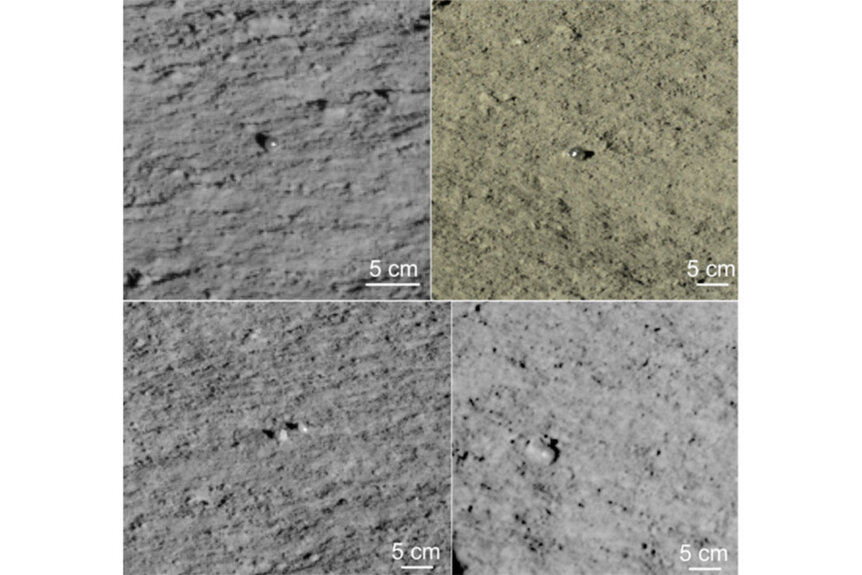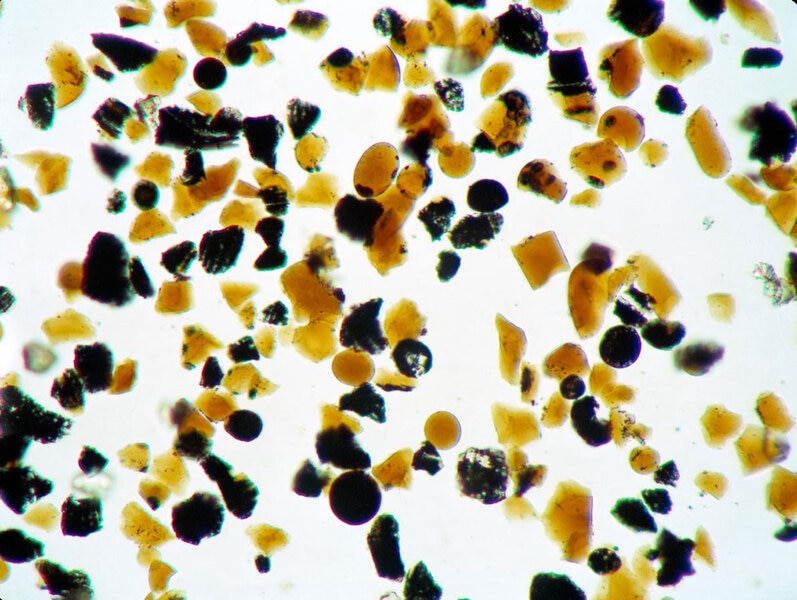Create a free profile to get unlimited access to exclusive videos, sweepstakes, and more!
Chinese rover spots a pair of glassy orbs on the Moon
Two small glassy spherules may have been ejected from an asteroid impact.

Of all the weird things I'd expect to see on the surface of the Moon, a couple of glass marbles would be way down on the list.
Yet that appears to be what the Chinese Yutu-2 rover has found: A pair glassy-looking spherules, just sitting there out in the open on the lunar dust (link to paper).
It's not clear how they formed or what they're doing there. Now, tiny glass beads are common in the lunar regolith — the dusty, gravelly material covering most of the Moon, created from micrometeorites eroding rocks and thermal expansion and contraction breaking them apart as well — but they're generally very small, even microscopic, usually a few tens to a couple of hundred microns across. A human hair is about 100 microns wide, for comparison.
It's thought these teeny glass beads are volcanic in origin, created as vapors blasting out of ancient lunar volcanoes cooled. If that material cools slowly it can form crystals, but if it cools rapidly there's not enough time for crystals to form, and the result is an amorphous structure: glass. Microscopic orange glassy beads were found on the surface by Apollo 17 — that's a cool story actually, and I imagine after seeing gray everywhere the sight of bright orange material on the Moon shocked the astronauts.
Another way for glassy beads to form is during a decent-sized asteroid or comet impact. The energy of the impact melts the surrounding material and blasts it out in plumes or jets. These break up into smaller bits as they fly over the surface which then cool rapidly to form glassy spheroidal beads as well. These can be up to 4 centimeters or so in size, and tend to be darker than the smaller volcanic microscopic beads.
That's what makes the new ones found so weird: One is about 1.5 and the other 2.5 cm wide, so biggish, but they also appear translucent at least in the images taken by Yutu-2. To be clear it's not possible to prove they are glass from the images alone, but given the circumstantial evidence outlined below it's not a bad bet.
If they are indeed glassy, how did they form?
The Chinese Chang'e 4 lander touched down in the huge 186-km-wide Von Kármán crater in 2019, the first time anyone had ever landed a mission on the Moon's far side. The crater is pretty interesting geologically; the floor is flat, indicating that some time after the impact that formed it lava flooded there, covering the floor. There's what looks like viscous volcanic upwelling in the southwest corner, and there's a massive landslide to the north that covers much of the crater floor. There are also indications that the crater surface has material from other, younger impacts nearby as well.
The Yutu-2 rover has traversed over a kilometer of lunar surface, and seen some pretty odd stuff, including a greenish blob of material that's likely glassy impact melt with some impurities that color it. But these newly found spherules still stand out. Literally; since they're sitting on the surface. If that's where they landed then they must be young; over time smaller impacts overturn the top few centimeters of regolith — a process called gardening, which I think is lovely — so they can't have been there long (tens to hundreds of thousands of years tops). On the other hand there are big chunks of rock around them that are likely pieces ejected from cratering, indicating that the glass spherules could have been under the surface for eons and thrown out by smaller, later impacts.
There's not a lot of evidence of eruptive volcanism in that exact area of Von Kármán where Yutu-2 is roving (the landing site is centered in the image in that link); the oozy-looking stuff in the southwest is about 100 km away from Yutu-2. Basalt, a common volcanic rock on the Moon, is hard to turn into glass on large scales because it tends to cool slowly and form crystals. The authors of the paper note that anorthosite is common in this area of the crater, which has a complicated geologic history. When heated by an impact and melted, anorthosites cool quickly enough that they can become glassy, so it's a decent candidate for the source material of the odd glass marbles. Yutu-2 is roving on top of a thick, 40-meter layer of debris blown out by impacts some distance away, so that fits as well.
The only problem is Yutu-2 doesn't have the right instruments to determine the composition of the spherules. That's frustrating, but it wasn't designed for that kind of analysis. It has a camera, a ground-penetrating radar to understand the layers of rock below the surface, a spectrometer which can determine some mineral compositions under some circumstances, and a neutral atom analyzer to see how the solar wind interacts with the lunar surface. None of these can do a compositional analysis of the glassy spherules.
But the authors note that finding two of them just sitting on the surface implies they could be common in this area, and perhaps other places on the Moon as well. Whether they're volcanic or impact in origin, they could have gasses trapped in bubbles inside them, which can then be analyzed on Earth to get a better idea of how and when they formed, providing insight on what the Moon was like in the past. At the moment multiple countries are planning extensive exploration of the Moon in the very near future, so we may soon know a lot more about these peculiar little lunar marbles.






























